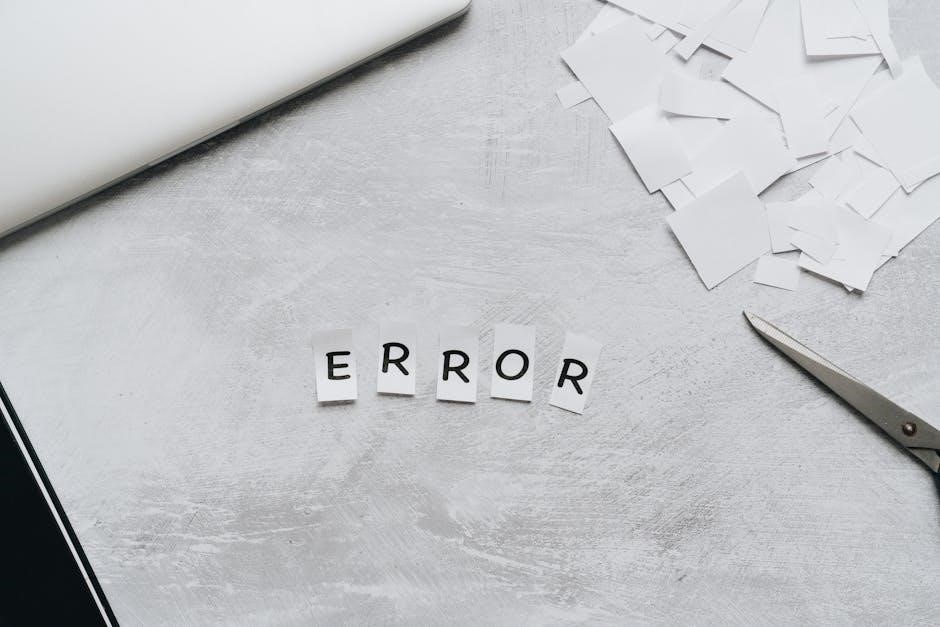Navien error codes are essential diagnostic tools for identifying issues in water heaters and boilers. These codes help users and technicians quickly pinpoint problems, from combustion and ignition faults to gas pressure and PCB failures. Understanding these codes empowers homeowners to take corrective actions, ensuring system efficiency, safety, and longevity. This guide provides a detailed overview of common error codes, their meanings, and solutions, helping you interpret and address issues effectively.
1.1 Understanding the Importance of Navien Error Codes
Navien error codes play a crucial role in diagnosing and resolving issues with water heaters and boilers. These codes are designed to provide clear and specific information about system malfunctions, enabling users and technicians to identify problems quickly and efficiently. By understanding these codes, homeowners can address issues early, preventing minor problems from escalating into major repairs. Error codes also help in determining whether a DIY fix is possible or if professional assistance is required. Regularly reviewing error codes can guide preventive maintenance, ensuring optimal system performance and longevity. Additionally, these codes enhance safety by alerting users to potential hazards, such as gas pressure issues or high-temperature anomalies. Overall, familiarizing yourself with Navien error codes is essential for maintaining efficiency, safety, and reliability in your heating system.
1.2 Overview of Navien Water Heater and Boiler Systems
Navien is a leading manufacturer of high-efficiency water heaters and boilers, known for their innovative technology and reliable performance. Their systems are designed to provide consistent hot water and space heating while minimizing energy consumption. Navien offers a range of models, including tankless water heaters and combination boilers, which are favored for their compact design and advanced features. These systems often include modulating burners, stainless steel heat exchangers, and smart controls for optimal efficiency. Navien’s products are also recognized for their eco-friendliness, as they typically operate at higher AFUE ratings compared to traditional systems. With proper installation and maintenance, Navien water heaters and boilers can last for 15 to 20 years or more, making them a long-term investment for homeowners. Understanding how these systems work is crucial for interpreting error codes and ensuring they function at their best.

Common Navien Error Codes and Their Meanings
Navien error codes provide clear insights into system malfunctions, helping users identify issues like combustion problems, gas pressure faults, or PCB failures. Understanding these codes enables quick diagnosis and effective solutions.
2.1 Navien Error Code E1: Combustion Issues
Navien Error Code E1 indicates a combustion issue, often related to improper gas supply or ignition problems. This code alerts users to potential faults in the burner or gas valve, which may stem from faulty wiring, obstructed venting, or insufficient gas pressure. Addressing E1 requires checking gas lines for leaks or blockages and ensuring proper ventilation. Cleaning or replacing faulty components, such as the ignition electrode, may resolve the issue. If the problem persists, consulting a licensed technician is recommended to ensure safe and efficient system operation. Regular maintenance can help prevent such issues, promoting reliable performance and extending the system’s lifespan.
2.2 Navien Error Code E2: Flow Sensor Problems
Navien Error Code E2 signifies issues with the flow sensor, a critical component that monitors water flow through the system. This code typically arises when the sensor detects irregular or insufficient flow, often due to scale buildup, debris, or faulty wiring. To resolve E2, inspect the flow sensor for mineral deposits and clean or replace it if necessary. Ensure all connections are secure and free from corrosion. In some cases, a malfunctioning circulation pump can also trigger this error, requiring adjustment or replacement. Regular descaling and maintenance can prevent such issues, ensuring optimal system performance and extending the lifespan of your Navien unit. If problems persist, consulting a professional is advisable to avoid further complications.
2.3 Navien Error Code E3: Ignition Faults
Navien Error Code E3 indicates an ignition fault, which prevents the system from igniting the burner properly. This issue is often linked to problems with the gas supply, ignition electrodes, or the ignition module. To diagnose E3, check if the gas valve is open and ensure there are no blockages in the gas line. Faulty or corroded ignition electrodes may require cleaning or replacement. Additionally, a malfunctioning ignition module could be the root cause, needing professional attention. In some cases, improper venting or air pressure issues might also trigger this error. Addressing E3 promptly is crucial to avoid further complications, such as system lockouts or safety hazards. If basic troubleshooting steps fail, it is recommended to contact a qualified technician to resolve the issue efficiently and safely.
2.4 Navien Error Code E4: Gas Pressure Issues
Navien Error Code E4 is related to gas pressure issues, which can disrupt the system’s ability to maintain proper combustion. This error often occurs when the gas pressure is either too low or too high, deviating from the recommended specifications. Possible causes include a faulty gas pressure regulator, blockages in the gas line, or incorrect gas line sizing. Additionally, issues with the gas valve or manifold pressure setting can trigger this error. To resolve E4, check the gas supply lines for any kinks or obstructions and ensure the gas valve is fully open. Verify that the gas pressure settings match the manufacturer’s recommendations, and inspect the regulator for proper function. If the problem persists, it may be necessary to replace the regulator or adjust the gas line configuration. Addressing gas pressure issues promptly is crucial to restore efficient and safe system operation.
2.5 Navien Error Code E5: Water Temperature Malfunctions
Navien Error Code E5 indicates a water temperature malfunction, which occurs when the system detects abnormal temperature levels in the water heater or boiler. This error can result from a faulty temperature sensor, incorrect temperature settings, or issues with the heating element. If the sensor is malfunctioning, it may provide inaccurate readings, causing the system to shut down as a safety precaution. Additionally, scale buildup or mineral deposits in the heat exchanger can disrupt proper temperature regulation. To resolve E5, check the temperature sensor for accuracy and ensure it is clean and free from corrosion. Verify that the temperature settings are within the recommended range and adjust if necessary. If the heating element is damaged, it may need to be replaced. Regular descaling of the heat exchanger can also help prevent this error. Addressing E5 promptly ensures reliable and efficient system performance. Always consult a professional if the issue persists after basic troubleshooting.
2.6 Navien Error Code E6: Fan or Venting Problems
Navien Error Code E6 signifies issues with the fan or venting system in your boiler or water heater. This error typically occurs when the system detects a problem with the fan’s operation or a blockage in the venting system. The fan is crucial for expelling combustion gases and ensuring proper airflow, so any malfunction can lead to system shutdown. Common causes include a faulty fan motor, blockages in the vent pipes, or issues with the pressure switch. If the venting system is clogged with debris or damaged, it can restrict airflow, triggering this error. Additionally, improper installation of venting components or corrosion over time can also contribute to E6. It is essential to address this issue promptly, as inadequate ventilation can lead to safety hazards, such as carbon monoxide buildup. To resolve E6, inspect the venting system for blockages, ensure the fan is functioning correctly, and check the pressure switch for proper operation. If the problem persists, consult a qualified technician to ensure safe and efficient system performance.
2.7 Navien Error Code E7: PCB (Printed Circuit Board) Failures
Navien Error Code E7 indicates a failure or malfunction in the Printed Circuit Board (PCB), which is the brain of your Navien system. The PCB controls all operational functions, including ignition, gas flow, and temperature regulation. If the PCB fails, the system cannot operate correctly, leading to this error. Common causes include power surges, electrical issues, or internal component failures. Over time, wear and tear can also degrade the PCB’s performance. In some cases, faulty sensors or wiring connections can trigger this error, as the PCB relies on accurate data from sensors to function properly. To resolve E7, a qualified technician should inspect and replace the PCB if necessary. DIY repairs are not recommended, as improper handling can cause further damage. Regular maintenance and ensuring stable power supply can help prevent PCB failures, ensuring your Navien system runs efficiently and safely.
2.8 Navien Error Code E8: Communication Errors
Navien Error Code E8 signifies a communication issue within the system, typically between the boiler, external controls, or remote sensors. This error occurs when there is a disruption in the data exchange necessary for proper operation. Common causes include faulty wiring, loose connections, or malfunctioning communication modules. Environmental factors like electromagnetic interference or power surges can also trigger this error. In some cases, a mismatched or outdated control board may fail to communicate effectively with other components. To resolve E8, inspect and tighten all wiring connections, ensuring they are secure and free from damage. If issues persist, a licensed technician may need to replace the communication module or update the system’s firmware. Addressing this error promptly is crucial, as uninterrupted communication is vital for efficient and safe operation of your Navien system.
2.9 Navien Error Code E9: High-Temperature Issues
Navien Error Code E9 indicates a high-temperature issue, which occurs when the system detects an excessively high temperature within the boiler or water heater. This error is triggered by overheating, often due to blocked vents, faulty temperature sensors, or poor circulation of water. If left unaddressed, it can lead to system damage or safety hazards. To resolve E9, first, ensure that all vents and pipes are clear of obstructions. Check the temperature sensor for accuracy and replace it if necessary. Verify that the circulation pump is functioning properly, as poor water flow can cause overheating. If the issue persists, a licensed technician should inspect the system to identify and repair any underlying problems. Addressing E9 promptly is crucial to prevent long-term damage and ensure safe, efficient operation of your Navien system.
2.10 Navien Error Code E10: Air Pressure Problems
Navien Error Code E10 signifies an issue with air pressure in the system, typically related to improper venting or blockages in the air intake. This error can disrupt combustion efficiency and overall performance. To diagnose E10, inspect the venting system for any obstructions or damage, ensuring it is clear and functioning correctly. Check the air intake pipes for kinks, blockages, or disconnections. Additionally, verify that the fan or vent motor is operating properly, as a malfunction here can trigger this error. If the problem persists, it may be necessary to adjust the air pressure settings or replace faulty components. Consulting a professional is recommended if DIY troubleshooting does not resolve the issue. Addressing E10 promptly ensures optimal performance and prevents potential safety hazards related to improper combustion or ventilation.
2.11 Navien Error Code E11: Water Leak Detection
Navien Error Code E11 indicates that the system has detected a water leak, which could be internal or external. This error triggers an automatic shutdown to prevent further damage. To resolve E11, inspect the unit and surrounding areas for visible signs of water leakage, such as puddles or moisture. Check all connections, pipes, and fittings for tightness and integrity. If a leak is found, turn off the water supply and power to the system before attempting repairs. In some cases, the error may occur due to a faulty water leak sensor or blockages in the system. Ensure the sensor is clean and functioning properly. If no leak is detected, the issue might be related to the sensor itself, requiring professional calibration or replacement. Addressing E11 promptly is crucial to avoid water damage and maintain system efficiency. Always follow safety guidelines when handling electrical and plumbing components.
2.12 Navien Error Code E12: Ignition Lockout
Navien Error Code E12 indicates an ignition lockout, which occurs when the system fails to ignite the burner after multiple attempts. This safety feature prevents potential hazards by shutting down the unit. Common causes include insufficient gas pressure, faulty gas valves, or issues with the ignition electrode. Additionally, blockages in the venting system, a faulty flame sensor, or wiring problems can trigger this error. To resolve E12, ensure the gas supply is stable and verify that all valves are fully open. Check for obstructions in the vent pipes and ensure proper airflow. Inspect the ignition electrode and flame sensor for cleanliness and functionality; clean or replace them if necessary. If the issue persists, it may indicate a more complex problem requiring professional intervention. Always prioritize safety when troubleshooting ignition-related errors, and consult a certified technician if unsure. Prompt action ensures your Navien system operates safely and efficiently.

Advanced Troubleshooting of Navien Error Codes
Advanced troubleshooting involves specialized tools and expert techniques to diagnose complex issues. This includes system recalibration, deep diagnostic checks, and addressing hidden faults beyond basic error code interpretations, ensuring comprehensive resolution.
3.1 Diagnosing Complex Error Codes
Diagnosing complex Navien error codes often requires a meticulous approach, combining technical knowledge with specialized tools. For instance, error codes like E7 (PCB failures) or E12 (ignition lockout) may stem from multiple factors. Technicians typically start by reviewing the error history to identify recurring issues, then perform a series of tests, such as checking gas pressure, flow rates, and electrical connections. Advanced diagnostic tools like multimeters and combustion analyzers are essential for pinpointing faults in components like sensors or PCBs. Additionally, consulting the Navien error codes PDF guide provides detailed troubleshooting steps and repair procedures. By systematically isolating potential causes, technicians can efficiently resolve even the most challenging issues, ensuring optimal system performance and minimizing downtime.
3.2 Tools and Equipment Needed for Troubleshooting
Troubleshooting Navien systems requires a range of specialized tools and equipment to accurately diagnose and resolve issues. Essential tools include a multimeter for checking electrical connections and voltage, a gas pressure tester to verify proper gas flow, and a manometer to measure pressure levels in the system. Additionally, a venting test kit is crucial for assessing venting performance, especially for error codes related to fan or venting issues like E6. A Navien-specific diagnostic kit, available from the manufacturer, provides advanced features tailored to Navien systems. For complex errors, such as PCB failures (E7), a soldering iron and replacement components may be necessary. Safety gear, including gloves and safety glasses, is also vital to protect technicians during the process. While some tools are designed for professionals, basic equipment like a multimeter can be used by DIY enthusiasts to perform preliminary checks before calling a licensed technician.
3.3 Step-by-Step Guide to Resetting Navien Systems
Resetting a Navien system can often resolve minor issues without requiring extensive repairs. Start by turning off the power to the unit at the circuit breaker or switch. Allow the system to remain off for 10-15 minutes to ensure all components cool down. Next, turn the power back on and check the error code display to see if the issue has cleared. If the error persists, consult the user manual or error code chart to identify the specific problem. For some models, resetting the system involves pressing and holding the reset button located on the control panel for 3-5 seconds. If the error code reappears, it may indicate a more serious issue requiring professional attention. Always ensure gas and water supplies are turned off before attempting any manual resets. If unsure, contact a licensed technician to avoid further complications.

Preventing Future Errors and Maintenance Tips
Regular inspections, cleaning, and water treatment can prevent Navien errors. Ensure proper venting, check for blockages, and maintain optimal water quality. Schedule annual professional servicing to catch issues early and extend system lifespan.
4.1 Regular Maintenance Schedule for Navien Systems
Regular maintenance is key to preventing Navien error codes and ensuring optimal performance. Start with monthly checks: inspect venting systems for blockages, clean air filters, and ensure proper gas supply. Every 6 months, descale the heat exchanger to prevent mineral buildup and flush the water heater to remove sediment. Annually, hire a professional to inspect and service the system, including checking gas pressure, ignition components, and flow sensors. Additionally, maintain proper water quality to avoid corrosion and scale formation. Keep records of maintenance activities to track system health. By adhering to this schedule, you can reduce the likelihood of errors, improve efficiency, and extend the lifespan of your Navien system. Consistent upkeep also ensures safety, as undetected issues can lead to hazardous conditions. Stay proactive to enjoy reliable heating and hot water year-round.
4.2 DIY Maintenance Tasks for Homeowners
Homeowners can perform several DIY maintenance tasks to keep their Navien systems running smoothly. Start by regularly inspecting and cleaning the air filters and venting systems to ensure proper airflow. Monthly, check the water filter and replace it if necessary to prevent mineral buildup. Every few months, flush the water heater to remove sediment and scale, which can cause error codes like E5 or E11. Additionally, inspect the gas line for leaks and ensure all connections are secure. For tankless models, descale the heat exchanger annually to maintain efficiency. Always refer to your user manual for specific instructions. While these tasks are manageable, some issues may require professional attention. By staying proactive, you can prevent common errors and extend the lifespan of your system. Remember, consistent DIY maintenance is a cost-effective way to avoid costly repairs and ensure reliable performance.
4.3 Professional Maintenance Recommendations
While DIY tasks are beneficial, professional maintenance is crucial for ensuring optimal performance and longevity of Navien systems. Licensed technicians can perform detailed inspections, including checking gas pressure, venting systems, and internal components like the PCB and ignition system. Annual servicing by a certified HVAC professional is recommended to identify and address potential issues before they lead to error codes. They can also perform advanced diagnostics and repairs, such as recalibrating sensors or replacing faulty parts. Additionally, professionals can ensure compliance with safety standards and manufacturer guidelines, which is especially important for maintaining warranty validity. Regular professional maintenance can prevent major breakdowns, improve energy efficiency, and extend the lifespan of your Navien system. By investing in professional care, you can enjoy reliable, error-free operation and peace of mind. Schedule annual check-ups to keep your system in peak condition and avoid unexpected repairs.

Understanding Navien error codes is crucial for maintaining efficient and safe system operation. Regular maintenance and timely repairs can prevent major issues, ensuring reliability and longevity. Always consult professionals for complex problems to guarantee optimal performance.
5.1 Summary of Key Points
Navien error codes provide critical insights into system malfunctions, enabling timely diagnoses and repairs. Common issues range from combustion and ignition faults to PCB failures and communication errors. Understanding these codes empowers homeowners to address problems promptly. Regular maintenance, such as checking gas pressure, flow sensors, and venting, can prevent many errors. DIY tasks, like cleaning filters and inspecting wiring, are essential for system longevity. However, complex issues like ignition lockouts or high-temperature malfunctions often require professional intervention. Preventive measures, including annual inspections and proper installation, ensure optimal performance. Navien systems benefit from consistent care, reducing the likelihood of error codes and extending their lifespan. By combining DIY efforts with professional maintenance, users can maintain efficiency, safety, and reliability. This guide has covered key error codes, troubleshooting steps, and maintenance tips to help users navigate Navien system issues effectively.
5.2 Importance of Timely Repairs and Maintenance
Timely repairs and maintenance are crucial for ensuring the longevity and efficiency of Navien systems. Ignoring error codes or delaying repairs can lead to more severe issues, higher energy bills, and even safety hazards. Regular maintenance helps prevent unexpected breakdowns and ensures consistent performance. Addressing problems early reduces the risk of costly repairs and extends the system’s lifespan. Proper care also enhances safety, as gas and electrical components require careful monitoring. Additionally, well-maintained systems operate more efficiently, lowering energy consumption and saving money over time. By prioritizing timely repairs and routine maintenance, homeowners can enjoy reliable hot water and heating while avoiding potential risks. This proactive approach not only protects the investment in Navien systems but also ensures a safer and more comfortable living environment.